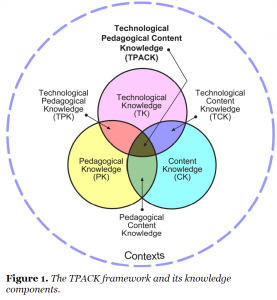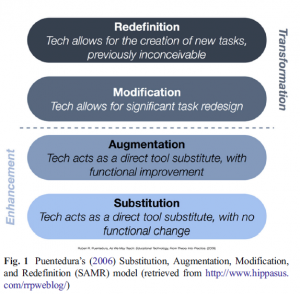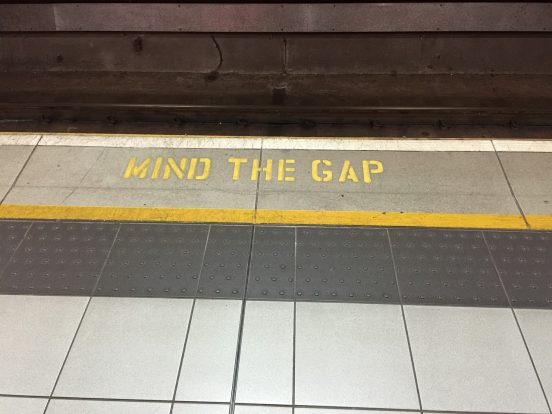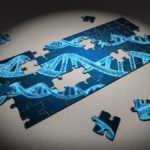In my readings for this week, I was tasked with learning about the TPACK and SAMR models for incorporating technology and identifying my position regarding their usefulness. Koehler & Mishra give an overview of TPACK illustrating how teaching involves the interplay between content, pedagogical and technological knowledge in the creation, delivery, and assessment of personalized learning experiences (image below). As the authors mention, good teaching involves flexible movement between these knowledge domains while exploring their interconnection to create relevant, and successful learning opportunities.

The TPACK model helps to identify and describe the complexities of the job of an educator and carve a path to promote a realistic understanding of how technological incorporation affects other domains of teaching. For each new technology, a holistic evaluation must take place that not only addresses the simple infrastructure logistics of its integration, but also in how that technology will affect content understanding and pedagogical assumptions about the overall structure of learning.
“This knowledge is unlikely to be used unless teachers can conceive of technology uses that are consistent with their existing pedagogical beliefs.”
This statement by Koehler & Mishra outlines my approach to adopting new technology. While it may be possible for me to adjust my pedagogy to help fulfill the potential of the new technology, often the implementation of new tech occurs with such haste as to limit me to improving the efficiency and/or efficacy of an existing pedagogical task within my “existing pedagogical beliefs.”
There exists a very noticeable gap between incorporation of a new tech and the point at which I can fully and completely maximize the potential of said tech to transform what is done in my course (I assume I am not alone). Koehler & Mishra also acknowledge the difficulty of making room for new tech in an educators already tight schedule:
“Acquiring a new knowledge base and skill set can be challenging, particularly if it is a time-intensive activity that must fit into a busy schedule.“
While I bristled at the connection to the word “transformative“ (currently very trendy in Ed-Tech conversations), the Transformation levels in the SAMR model discussed by Hamilton et al. do accurately pinpoint the goal most educators set when incorporating a new technology (image below).

It is this time-constraint that often forces educators, who often willingly and eagerly adopt new tech, into the first two simple Enhancement levels of the SAMR model – this is not for lack of interest on the part of the educators. And while inadequate training is often mentioned as an impediment to adding technology, I would argue this is not true. A lack of training will not stop the eager adopter; but it will limit their understanding of how that tech may move into the Modification and Redefinition levels. With time and exposure (assuming the educator can persevere through initial struggles, and the tech at minimum fulfills an Augmentation or Substitution functionality) an educator will then evaluate and reflect on new and transformative ways to utilize said tech.
“Despite the larger implied message of the SAMR model…using technology (even at the substitution level) is not always better nor is it always necessary.”
In referencing some challenges to the SAMR model, I found myself appreciative of the above quote from Hamilton et al. This statement connects back to our previous discussions on the Clark/Kozma debate regarding the use of technology without consideration of the embedded instructional methods that may make it successful. This acknowledgement by Hamilton et al. supports Clark’s assertion that the instructional method that achieved learning performance results is an important focal point that must be identified in the evaluation of new technology. Which also uncovers another flaw of SAMR – it focuses on technology to provide “inconceivable” new tasks, when evaluating pedagogy or content knowledge (as in the TPACK model) could provide another route for transformation.
Ultimately, an amalgamation of these two frameworks is the most likely solution for most educators. While the TPACK model has the advantage of outlining a descriptive way of thinking in regards to how best to implement a new technology, the ripple-effect that occurs in other knowledge domains, and the context in which the technology will be used, for most educators the desire to implement technology comes with a lack of thorough training and time to creatively assess these ramifications or potentials.
This leads a teacher to enter the lower SAMR levels as an initial step that accomplishes the bare-minimum – incorporating new tech. From this point the educator, once more comfortable with the tech, can begin to evaluate its place from a perspective of the knowledge domains of the TPACK model with the goal of moving up the SAMR levels of prescriptive improvement.
In these articles, Hamilton et al. and Koehler & Mishra acknowledge both “the complex systems” of education and the “ill-structured nature” of teaching. And while the authors also note the potential of amalgamating the two models in discussion here, these acknowledgements lead to an educational certainty: teachers need a more varied or complicated technology-integration model than those currently on offer.
PHOTO: By walkerud97 on Pixabay (Free for commercial use/No attribution required)






